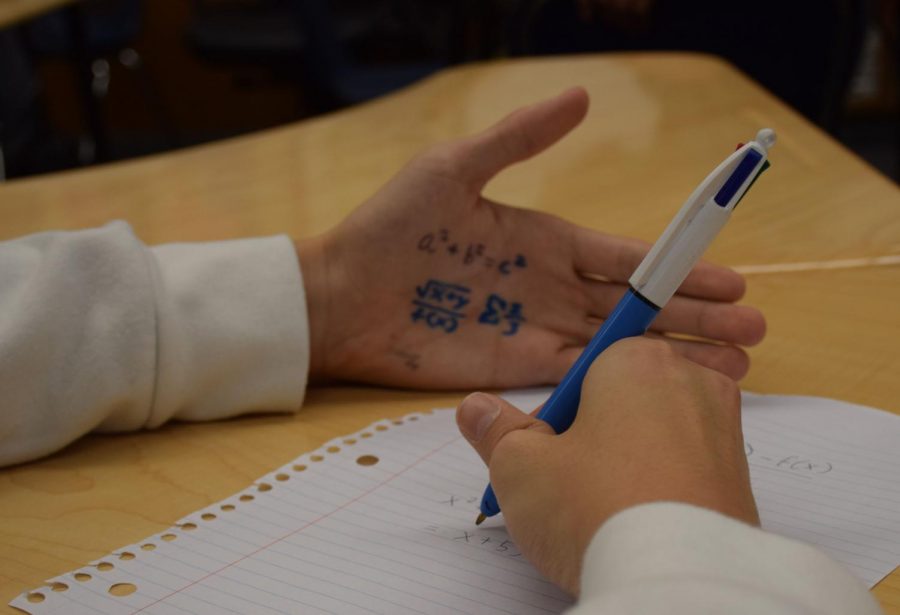Cheating: Survey Reveals Questionable Campus Character
October 7, 2019
While Campolindo ranks 30th on the US News California High School list, and sends many students on to the nation’s top colleges, new findings suggest there is a problem with academic integrity on its campus.
87.6% of Campolindo students admitted to cheating within the previous month on the 2019 Stanford Survey of School Experiences.
Results of the survey were presented to the public on September 19.
“Sounds about right,” said junior Robert Nykodym. “I feel like most people at Campo probably cheat.”
This is the 3rd time that the Stanford Survey of School Experiences has been administered to Campolindo students. The data compiled by the survey helps the school administration tackle issues like sleep deprivation, phone addiction, school safety, and yes, cheating.
According to Principal John Walker, the School Advisory Council, which aims to improve the school by developing action plans, has utilized this survey data in the past to help propose new programs such as the block schedule and targeted intervention during the academy period.
According to the survey results, which tracked the many different “categories of cheating,” within the month prior to taking the survey, 62.7% of students turned in copied homework, 51.2% got test questions or answers from a peer who had taken the test already, and 29.2% helped a peer cheat on an assessment.
These high cheating rates align with survey results from 2015 and 2017, which reported cheating rates of 92.5% and 92.3%, respectively.
Walker, who held an informational meeting on September 19 to discuss the new survey results with parents, was initially “surprised” when he saw these rates in 2015. “However, when I looked at all the different ways that students can show a lack of academic integrity, I noticed that the number one way involved copying homework and that made sense to me,” he said.
Yet these staggeringly high cheating rates may suggest that academic dishonesty has been normalized among the student body.
“In the hallways everywhere, people are always asking each other about what was on the tests. People also literally talk about the test questions in front of the teachers. It’s like no one even notices they are doing it anymore,” said sophomore Charlotte Anderson.
The pervasiveness of cheating may also stem from discrepancies in what students consider cheating. “Students do not perceive copying homework as cheating. Students don’t perceive talking about an exam or what is on an exam as cheating and that is cheating,” said AP Art History teacher Molly Kerr.
Some students admitted to seeing their peers cheat frequently, but never intervene. They also recognized the number of innovative methods in which students are able to cheat during tests.
“I’ve seen a bunch of people cheating mostly on like big chapter tests, and a lot of people in different periods take pictures of the tests and send it to people. I’ve also seen people, like for English, have vocab sheets under their foot,” said a sophomore who asked to remain anonymous.
More complex, collaborative cheating schemes have also taken place.
A junior reported being a part of an elaborate setup in her math class with at least 10 others students, which they fondly nicknamed “The Geometry Ring.” After realizing that their teacher gave the same tests every year, the members obtained test questions from upperclassmen and shared them in a group chat. “I did what I could to survive that class,” said the junior. “I don’t care. I have no remorse.”
Student sources also claim that teacher’s aides change their peers’ test scores while grading assignments to help out their friends.
In yet another scheme, AP Environmental Science teachers Tren Kauzer and Jane Kelson reported that, several years ago, they discovered that some of their students repeatedly broke into classrooms during the night over the course of 6 months to steal tests, both for themselves and to sell to other students.
The 2 “ringleaders” ended up being sued for stealing intellectual property. “These students ultimately were caught because they thought it was so funny what they were doing, that they actually took videos of themselves, like crawling through the windows,” said Kauzer.
Some students attribute the high frequency of cheating to the pressure that comes from attending a competitive school, particularly the pressure created by their peers. “Everyone else shares their grades with each other and stuff, so you just want to have the best,” said sophomore Ella Fisher.
“In our Campo bubble, the belief is that at Campo you have to have the perfect grade so a lot of people all strive for that, but they know they can’t get it, so they have to get it through cheating,” agreed sophomore Kendall Keely.
The cheating culture may have repercussions that last beyond high school. “It’s funny because all our teachers always talk about how, because Campo is such a hard school, it will prepare us better for college, but on the other hand, this culture that we’re so proud of might actually make students more dishonest in the future just because we don’t learn to deal with a bad test score,” said junior Shantel Bonet.
The Stanford Survey also found that 68.8% of students said they rarely, if ever, found their schoolwork interesting or valuable, suggesting another factor that may be contributing to the cheating culture.
“I tend to copy people’s work, because I think that the work is kind of, like, pointless. There’s no meaning to it, especially since I’m not gonna need it in my future, especially in what I want to do as a job in the future,” said a junior.
Walker said that there is no “1 easy solution” to stop students from cheating, but he believes changing student and parent perspectives about college is key to reducing stress-induced cheating. “I think we want to emphasize students should be pleased when they’ve tried their hardest, when they really put in the best effort. Students need to have a realistic understanding of college admissions,” he said.
According to Walker, the administration has attempted to “spread the message” to families through “Campo Connect” presentations and other parent lectures. The Wellness Center, implementation of block scheduling, academy period, and new policy that limits homework to 2 hours per week for non-AP classes are all efforts to reduce academic stress. “I’ve been pleased to see the percentage [of students cheating] going down, but it’s still too high,” said Walker.
However, some students don’t feel that enough effort has been dedicated toward curbing cheating. “I feel like they are not doing anything to prevent cheating. They’re just finding ways to punish it,” said Nykodym.
There are also students who believe cheating will continue regardless of the changes. “No matter what you do, people will always cheat and not just at Campo,” said Keely. “We rely on others for so much that it’s so hard to do work on our own stuff that when they put a test in front of us, it’s hard for us to not go to others for help.”






